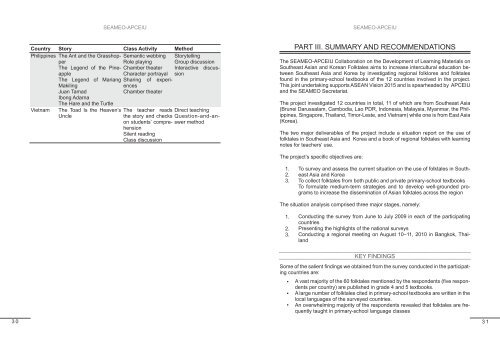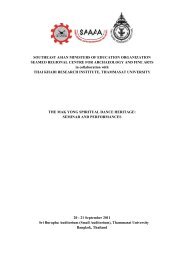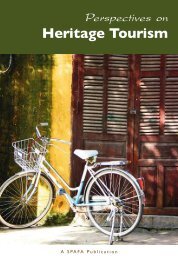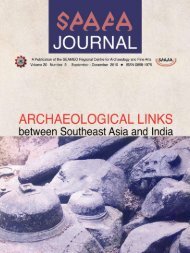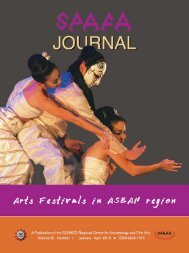Untitled - Telling Tales from Southeast Asia and Korea - APCEIU
Untitled - Telling Tales from Southeast Asia and Korea - APCEIU
Untitled - Telling Tales from Southeast Asia and Korea - APCEIU
- No tags were found...
You also want an ePaper? Increase the reach of your titles
YUMPU automatically turns print PDFs into web optimized ePapers that Google loves.
SEAMEO-<strong>APCEIU</strong>SEAMEO-<strong>APCEIU</strong>Country Story Class Activity MethodPhilippines The Ant <strong>and</strong> the GrasshopperSemantic webbingRole playingThe Legend of the PineappleChamber theaterCharacter portrayalThe Legend of Mariang Sharing of experiencesMakilingJuan TamadChamber theaterIbong AdarnaThe Hare <strong>and</strong> the TurtleVietnam The Toad Is the Heaven’sUncleThe teacher readsthe story <strong>and</strong> checkson students’ comprehensionSilent readingClass discussionStorytellingGroup discussionInteractive discussionDirect teachingQuestion-<strong>and</strong>-answermethodPART III. SUMMARY AND RECOMMENDATIONSThe SEAMEO-<strong>APCEIU</strong> Collaboration on the Development of Learning Materials on<strong>Southeast</strong> <strong>Asia</strong>n <strong>and</strong> <strong>Korea</strong>n Folktales aims to increase intercultural education between<strong>Southeast</strong> <strong>Asia</strong> <strong>and</strong> <strong>Korea</strong> by investigating regional folklores <strong>and</strong> folktalesfound in the primary-school textbooks of the 12 countries involved in the project.This joint undertaking supports ASEAN Vision 2015 <strong>and</strong> is spearheaded by <strong>APCEIU</strong><strong>and</strong> the SEAMEO Secretariat.The project investigated 12 countries in total, 11 of which are <strong>from</strong> <strong>Southeast</strong> <strong>Asia</strong>(Brunei Darussalam, Cambodia, Lao PDR, Indonesia, Malaysia, Myanmar, the Philippines,Singapore, Thail<strong>and</strong>, Timor-Leste, <strong>and</strong> Vietnam) while one is <strong>from</strong> East <strong>Asia</strong>(<strong>Korea</strong>).The two major deliverables of the project include a situation report on the use offolktales in <strong>Southeast</strong> <strong>Asia</strong> <strong>and</strong> <strong>Korea</strong> <strong>and</strong> a book of regional folktales with learningnotes for teachers’ use.The project’s specific objectives are:1.2.3.To survey <strong>and</strong> assess the current situation on the use of folktales in <strong>Southeast</strong><strong>Asia</strong> <strong>and</strong> <strong>Korea</strong>To collect folktales <strong>from</strong> both public <strong>and</strong> private primary-school textbooksTo formulate medium-term strategies <strong>and</strong> to develop well-grounded programsto increase the dissemination of <strong>Asia</strong>n folktales across the regionThe situation analysis comprised three major stages, namely:1.2.3.Conducting the survey <strong>from</strong> June to July 2009 in each of the participatingcountriesPresenting the highlights of the national surveysConducting a regional meeting on August 10–11, 2010 in Bangkok, Thail<strong>and</strong>KEY FINDINGSSome of the salient findings we obtained <strong>from</strong> the survey conducted in the participatingcountries are:A vast majority of the 60 folktales mentioned by the respondents (five respondentsper country) are published in grade 4 <strong>and</strong> 5 textbooks.A large number of folktales cited in primary-school textbooks are written in thelocal languages of the surveyed countries.An overwhelming majority of the respondents revealed that folktales are frequentlytaught in primary-school language classes3031


